7 Safe Tent Heating Ideas That Work
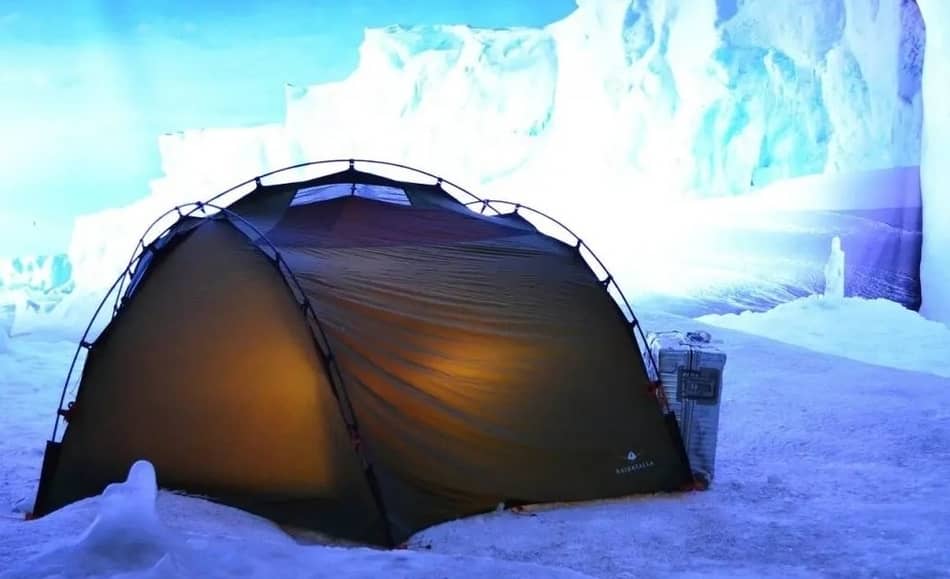
Let me guess, you don’t like when your wonderful camping trip is ruined by freezing nights and a cold tent? Nobody likes being cold, so to avoid such things, we’ll provide you with 7 tent heating methods that you can use during wintertime to keep you warm. All of them are safe, so you don’t need to worry. Let’s start!
Note! It’s not so simple to keep a tent warm since there is only a tiny layer of cloth between your sleeping space and the cold outside air. To get the best results, you may need to combine some of these techniques.
Also, if you want to know more about this topic, be sure to read: Do Canvas Tents Need Waterproofing?
Table of Contents
How to Heat a Tent Without Electricity?
I prefer the concept of camping in the woods without any electricity or electronics so I can get the full camping experience and enjoy the time away from the city to the fullest. Of course, electronics may help you heat your tent more quickly, but is it worth it? It all depends on what your priorities are.
When I left out the electricity, I found only 7 ways how you can heat your tent. I’m not going to tell you to light a fire in your tent. For real, don’t even think about it.
Therefore, is there really a safe way to heat a tent? With the aid of thermal mass, the answer is YES! Thermal mass is a material’s ability to absorb and store heat from a heat source such as a campfire and sun and slowly release it over time.
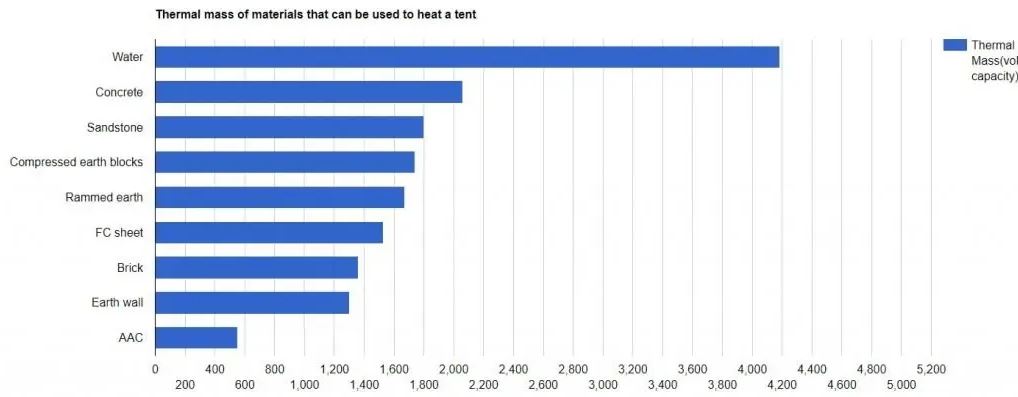
A list of conventional materials and their thermal mass numbers may be seen in the graph above. We can clearly see that water has the highest thermal mass of any of them. With that said, let’s look at how we can heat our tents with the use of water.
1. Heat Tent by Using Hot Water Bottles
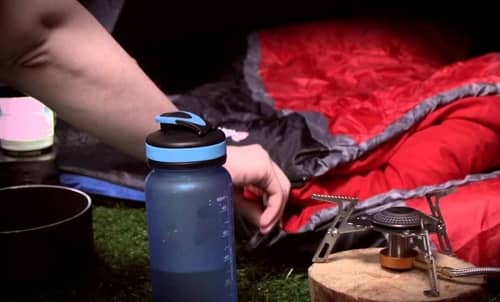
Farmers commonly use this method to heat their tents. Large greenhouses can be heated by using only barrels and water. Therefore, let’s have a look at how we may apply this strategy to our camping needs.
You’ll need to get some hard plastic or metal bottles if you want this to work. Plastic bottles that you can buy in the supermarket will not be good enough because the water must be heated close to boiling temperatures. To heat the water, you’ll need something like a boiling pan. And of course, let’s not forget the fire.
Advice! Keep in mind that the bigger the bottle=better the heating system you will have. The larger the bottle’s capacity, the longer the water can hold and release heat.
After the water has reached the desired temperature, pour it carefully into the bottles and distribute them throughout the tent. This will keep your tent warm by gradually raising the temperature for several hours, of course, if you do it right.
In most cases, you’ll wake up with the bottles still warm since the water is so dense. During the night, if they aren’t very warm, you can bring a couple of them near you to warm up your body.
At least, that’s how I do it. In my opinion, this is the greatest way to heat up your tent safely.
2. Use Heating Rocks to Warm Your Tent
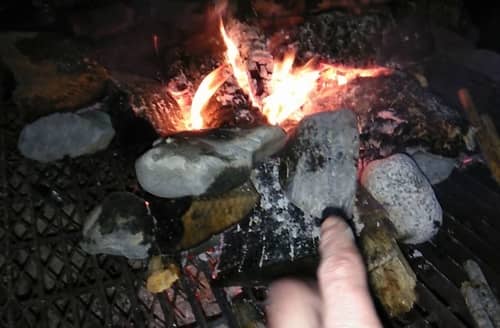
Heating your tent by using this method is even faster than heating it with water bottles, but there is a little issue. If you look at the previously mentioned graph, you can see that stones can only store heat for a short period.
But here’s what I’ve discovered to work. First, collect some stones in your camping spot. The best place to look for rocks is generally along a stream or a river. Make a fire and set the stones right next to it.
If you toss them in the fire, you’ll have a hard time getting them out. You don’t want to carry burnt stones inside your tent, do you?
Wrap the stones in a cloth approximately ½ hour before you go to sleep (Keep in mind that they can be pretty hot). After doing so, spread them throughout your tent. Try to place them in the areas where you’re less likely to come into contact with them.
Related Article: What’s The Lowest Temperature a Human Can Survive?
They should be quite hot if you wrap them the right way, and the material should prevent them from melting the tent.
They’ll be cold in 3-4 hours, but they’ll emit heat faster than water bottles. Doing this in combination with some warm clothing may make a significant impact. As a result, you may achieve nice temperatures and remain warm till the next morning based on how chilly it is outdoors.
3. Insulate Your Tent
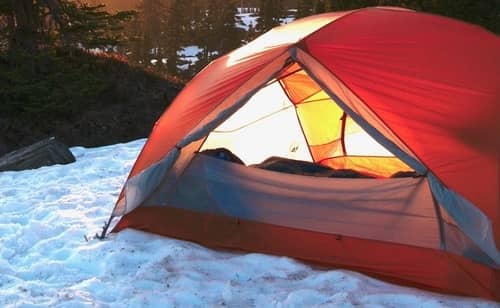
This strategy is most effective when we compare it with the previous methods. Insulating a tent is designed to keep warm air inside while bouncing it back to you. If the weather isn’t too cold, adequate insulation ensures that the tent is kept warm just by your body heat.
If you want to learn more, you can read my article: 10 Ways to Insulate Your Tent for Winter Camping.
4. Place Tent on Top of a Campfire
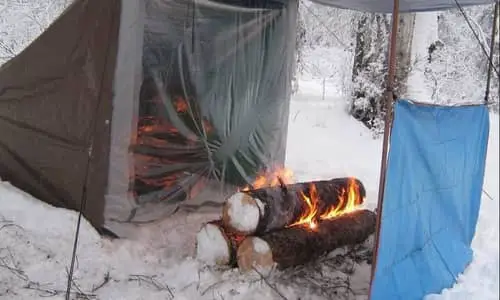
I’ve personally never done this, but it should work. This is my take on doing this. I’d make a hole and light a fire in it. The depth of the hole shouldn’t be too big, but the width should fit your tent as precisely as possible.
I’d recommend burning a great amount of wood to get as many coals as possible. When it’s time to go to sleep, I’d fill up the hole with dirt and set up the tent on top of it. Overnight, the heat should gradually rise from the ground.
Note! Don’t use an insulated sleeping mat on the tent floor if you decide to do this. They function by bouncing heat back to its source, so instead of heating your tent, you’ll be heating the ground.
You might be wondering how did I even think of this method and how will this work? Pit cooking is the source of my inspiration for this one. This has been done for a long time. They would dig a hole, start the fire in it, wait for the wood to burn out, and then place the food in it, allowing it to cook for hours.
In principle, it’s a fantastic idea, but I can immediately see several disadvantages. The first, and the most unpleasant, is that you will have to wait until late at night to set up your tent.
We’ve all experienced the frustration of raising a tent in low-light conditions. The second disadvantage, in my opinion, is that you must give up the fire.
Electric Heaters For Tents
In case you have a bigger tent, you’ll almost certainly need to rely on technology if you want to keep it warm. However, you should also know what heating equipment is safe to use.
When you go camping, you want to spend time with your family and get a good night’s sleep. Nobody wants to worry about touching the hot radiator while sleeping. No one likes the idea of waking up every now and then, afraid that these heating gadgets would cause your tent to bursting into flames. In the next section, we’ll talk about the best methods that you can use to heat up larger tents.
5. Use an Electric Blanket
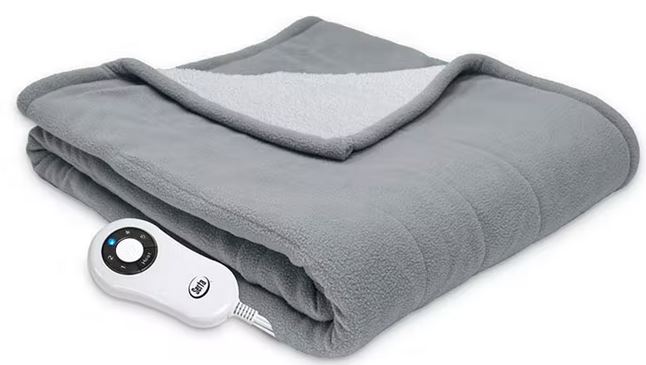
I already know what you’re thinking, “I came here to see how do I heat my tent rather than how I’m supposed to wrap myself in a blanket”. But let me stop you there. There aren’t many options for properly heating a tent, and I won’t suggest buying a tent stove or a propane heater.
The idea is to look for a high-quality electric blanket that works well and doesn’t use too much power. It’s worth noting that they’re completely safe.
Thin electrical wires are generally integrated into the fabric of these blankets. The wires won’t contact you directly, and most of these blankets have an automated turn-off system that prevents them from overheating.
Why heat the tent if you can get a large enough blanket to cover your whole body? Electric blankets have a heating range from 77°F (25°C) to 118°F (48°C) in most cases.
However, you’ll likely discover that the most pleasant temperature is slightly above your body temperature. Even if it’s chilling outside, your feet will be warm and cozy under one of these.
If you only use it for camping, a good electric blanket should last you at least 10 years. However, the wires will lose part of their conductance over time, and the maximum temperature may decrease, simultaneously increasing power usage.
If you have a camper, you’ll probably want to know How To Heat the Camper Without Electricity?
But, like everything else, these also have their disadvantages. You’ll need to be close to a power supply and might want to double-check the cord length. Although you may use a generator as a power source, generators are rather expensive.
Note! Keep in mind and don’t use your sleeping bag’s blanket in combination with the electric one. In order to avoid overheating, the heat created by the blanket must naturally disperse. Putting it in a sleeping bag might lead to overheating.
6. Use Underfloor Heating Carpets In Your Tent
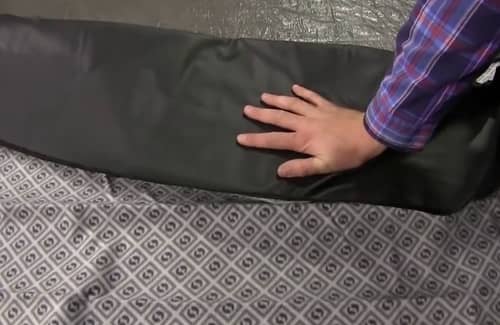
They function similarly to electric blankets, but they can be used on the whole tent floor, and a sleeping bag can still be used without the risk of overheating. We suggest you place them underneath the heated carpet, place a heat reflecting mat.
This is good because it prevents the coldness of the ground from entering the tent, simultaneously bouncing the heat from the carpet back in as opposed to letting it heat the ground.
Related Article: How Warm Is 600 Fill Down? Explained
7. Portable Electric Radiators
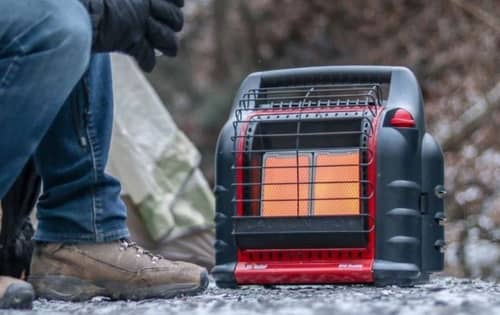
Radiators have never been my favorite, and let me tell you why. The heat they generate is usually weak. It takes about 20 minutes for the temperature to drop back once you turn them off. The warm air will rise and flee the tent, and you’ll end up being cold and not able to get a good night’s rest.
However, if you prefer radiators, I recommend searching for oil-filled models. You won’t have to put up with the obnoxious fan sounds that most produce. And the heat is a little more realistic.
However, they take up a lot of electricity, so you’ll definitely need a generator, and I’m quite sure they’re difficult to transport because they’re loaded with oil.
If you have Mr. Heater, then be sure to read about 6 Common Mr. Heater Pilot Light Problems.
Things To Avoid When Heating Your Tent
Numbers of articles on the internet recommend gas heaters and stoves as ways to heat up the tent. This is extremely dangerous because of the carbon monoxide (CO) they emit, and I highly advise against using any heat sources that do so.
CO, also known as the “silent killer”, is the most dangerous gas out there. Any heating device that releases it requires a good ventilation system. This is rather hard to achieve in a tent without damaging the insulation.
Here’s an example. Let’s imagine you’ve discovered a safe technique to release CO and wish to utilize a propane heater. Are you aware of the 3lbs of water that 5lbs of propane produces when it is burned? Where will that water go?
Everything, including your clothing, will be moistened in your tent. This will cause you to lose your body heat extremely quickly. Let’s not forget about the possibility of mold gradually growing everywhere.
If you want to know more, 10 Ways to Insulate Your Tent for Winter Camping.
Final Thoughts
The conclusion of the story is to be safe and careful. Use tried-and-true techniques that pose few to no dangers. If you don’t want to rely on natural sources to keep your tent warm, do some homework before purchasing a heater for your camping trips.
Whatever method you use for heating, be sure you’re using an adequate tent for the season. I hope that this article has helped you and for any other questions feel free to comment below.

Thank you very much for sharing, I learned a lot from your article. Very cool. Thanks. nimabi
Thank you very much for sharing, I learned a lot from your article. Very cool. Thanks. nimabi
Can you be more specific about the content of your article? After reading it, I still have some doubts. Hope you can help me. https://www.binance.com/fr/join?ref=UM6SMJM3
Thank you for your sharing. I am worried that I lack creative ideas. It is your article that makes me full of hope. Thank you. But, I have a question, can you help me?